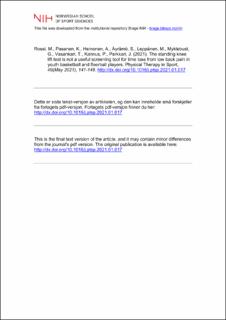The standing knee lift test is not a useful screening tool for time loss from low back pain in youth basketball and floorball players
Rossi, Marleena; Pasanen, Kati; Heinonen, Ari; Äyrämö, Sami; Leppänen, Mari; Myklebust, Grethe; Vasankari, Tommi; Kannus, Pekka; Parkkari, Jari
Peer reviewed, Journal article
Accepted version
Permanent lenke
https://hdl.handle.net/11250/2993854Utgivelsesdato
2021Metadata
Vis full innførselSamlinger
- Artikler / Articles [2119]
- Publikasjoner fra Cristin [1107]
Sammendrag
Objectives: The aim of this study was to investigate the association between pelvic kinematics during the standing knee lift (SKL) test and low back pain (LBP) in youth floorball and basketball players. Design: A prospective cohort study. Setting: Finnish elite youth floorball and basketball players. Participants: Finnish elite youth female and male floorball and basketball players (n = 258, mean age 15.7 ± 1.8). Main outcome measures: LBP resulting in time loss from practice and games was recorded over a 12-month period and verified by a study physician. Associations between LBP and sagittal plane pelvic tilt and frontal plane pelvic obliquity during the SKL test as measured at baseline were investigated. Individual training and game hours were recorded, and Cox’s proportional hazard models with mixed effects were used for the analysis. Results: Cox analyses revealed that sagittal plane pelvic tilt and frontal plane pelvic obliquity were not associated with LBP in floorball and basketball players during the follow-up. The hazard ratios for pelvic tilt and pelvic obliquity ranged between 0.93 and 1.08 (95% CIs between 0.91 and 1.07 and 0.83 and 1.29), respectively. Conclusions: Pelvic movement during the SKL test is not associated with future LBP in youth floorball and basketball players.
Beskrivelse
Dette er siste tekst-versjon av artikkelen, og den kan inneholde små forskjeller fra forlagets pdf-versjon. Forlagets pdf-versjon finner du på sciencedirect.com / This is the final text version of the article, and it may contain minor differences from the journal's pdf version. The original publication is available at sciencedirect.com
